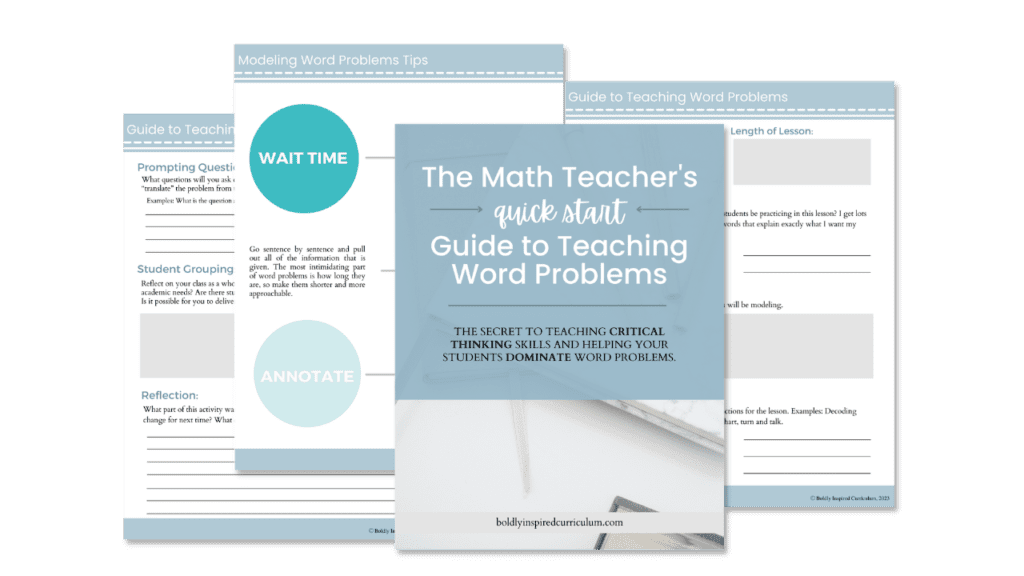Any time I ask math teachers about their frustrations with teaching new content the overwhelming majority is their students’ lack of problem solving and critical thinking skills. These struggles often present themselves when teaching math word problems.
Let’s face it… your students hate word problems in math class and college doesn’t prepare you to know how to teach them. Like most things, it’s all just trial and error.

Table of Contents
ToggleMistake #1: Having a negative view on word problems.
One of the worst things that you can do when teaching word problems is perpetuate the fixed mindset within your students. Students hate word problems because they are different from what they’re used to, they need to actually use their brain to solve the problems, they have spent years thinking that word problems are hard, and they don’t know how to start.
Not knowing where to start is one of the most challenging aspects of a word problem for many students. When teachers allow students to give up right away, there is no accountability or opportunity for them to strengthen their problem solving skills.
Try this instead:
You can empathize with your students and tell them that you know that word problems can be challenging but you want to pair this with strategies for how they can work through their struggles and solve them on their own. If you’re able to get your students to buy into the lesson and be more engaged with the word problems then it will be less likely for your students to give up right away.
Mistake #2: Trying to teach math word problems when students don't feel confident with the foundational skills.
Your students will not be able to feel confident in their ability to solve word problems if their foundational skills are not and almost automatic. The best way to ensure that students are confident in solving math word problems is to encourage a growth mindset.
This can be done through a variety of tactics. My personal favorite is normalizing making mistakes. I have made plenty of mistakes as a math teacher and my students always call me out on it. However, the trick to normalizing these mistakes is how you react to it. Acknowledge the mistake and then quickly move on.
Teachers need to ensure that they are practicing what they preach by modeling a growth mindset in their classroom. It’s essential for students to know that everyone makes mistakes and the best thing you can do is learn from it and move on.
Mistake #3: Always walking students through a problem
This is my biggest tip for math teachers. Any time you give students a new problem it’s important to provide them with problem solving strategies, such as drawing a picture, underlining the text, pulling out important information, etc..
However, you need to allow them to work through the struggle in order to solve the problem. I’m not saying that you shouldn’t give them examples of modeling the problem solving process because there is still a time and a place for that as well. This is especially true when students get to the high school level and problems become more complex.
What I am saying is that students need to have the opportunity to work as a team with their classmates, use the strategies that you’ve given them, and apply them to word problems. If teachers are always walking students through a problem they are never going to learn how to start the problem on their own.
If you think about the role of a teacher being a facilitator of learning, then you’ll see that the students are going to be doing a majority of the work and you are going to be there to support them.
Picture this:
Think about it as if you are the supervisor and your students are your employees. If you assign an employee a task, you want them to be able to solve the problem and give their own answer.
If you, as the employer, are walking your employee through the entire process you might as well just be doing it yourself. That is not going to be beneficial to the boss or to the employee because the employee is not learning the skills that they need to problem solve in their place of work and then what are you paying them for.
Mistake #4: Always calling on the first student who raises their hand
Calling on the first student who raises their hand is detrimental to any classroom environment. This often discourages students from actually thinking about the question that you asked and gives them a reason to let other students in the class overshadow them.
If they know that someone else will always answer quickly, then there is really no need for them to actually use their brains and think about your question. Making your expectations clear from the beginning that all students are expected to be engaged and participate will increase student engagement in your classroom exponentially.
One of my favorite math teacher consultants, Juliana Tapper, is a huge proponent for cold calling in the math classroom. This is typically a not well-received strategy. However, when expectations are set from day one and an inclusive classroom community is built, the results are incredible.
Utilizing wait time when solving math word problems is essential. I love modeling word problems and going through a real world application as a whole class so that we can get everyone’s ideas.
What I have found to be the most important part of modeling math word problems is giving all of my students the time to think about the problem before having anyone answer. Everyone’s brains work in different ways and one student may be quick to answer for one type of problem and another student may be quick to answer for a different type of problem.
Whenever I am teaching word problems, I tell my students to take one minute to think about their answer and then write it down. I don’t want them to shout out or raise their hand prematurely. I want them to think about their answer and then write it down. Once I have seen that most students have written down answers, I can then call on whoever I want to give their ideas.
My final thoughts about teaching math word problems
I am going to leave you with this last piece of advice for teaching word problems. it is not going to happen overnight. You are not going to make every student confident in solving math word problems after one lesson.
This is going to take weeks of small changes and perspective shifts in your classroom to ensure that your students are developing a growth mindset and critical thinking skills. Set the expectation that word problems are not going away and that they are the reason why they are in math class in the first place.

